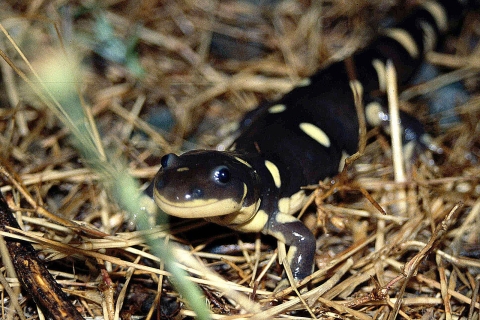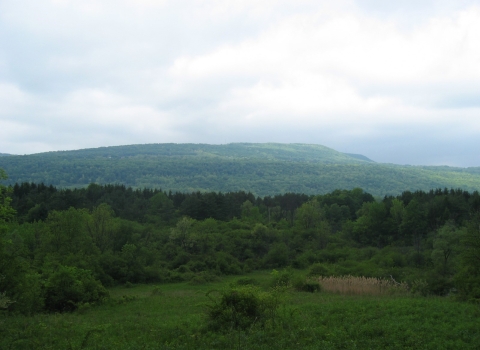Salamanders are one of nature’s many underappreciated marvels. Hidden from our eyes under logs and leaf litter or in caves and ponds, in some areas of the United States salamanders are so abundant that they make up a large portion of the vertebrate biomass. The diversity of salamanders is also notable. The United States has 221 native salamander species—more than any other country.
Although the tiny amphibians are rarely seen by humans, they contribute to the health of woodlands in a big way. Collectively, salamanders contribute to ecosystem health by eating the insects that would otherwise consume leaf litter and release that carbon to the air. They are also an important part of freshwater and terrestrial food webs andtransfer energy between freshwater and terrestrial ecosystems. Thus, they are a valued part of the wild fauna of the United States.
If salamanders are so important, why are we designating them as injurious?
In general, we add wildlife species to the injurious list (under 18 U.S.C. 42) if they are harmful in some way, such as a nonnative species that becomes invasive and preys on native plants or animals. In this case, however, the salamanders themselves aren’t harmful. The reason we are listing them as injurious is because they can carry a fungus (Batrachochytrium salamandrivorans, or Bsal) that is lethal to some amphibians. This fungus attacks the skin of some salamander species and causes a disease (chytridiomycosis) and often death of the infected animal. Bsal spores can be transferred from one salamander’s skin to another, infecting more salamanders. Therefore, we consider the salamanders injurious because they can carry the harmful fungus to more salamanders.
Fortunately, the fungus is not yet found in the wild in the United States.
The Bsal fungus was discovered in Europe in 2013, where it devastated populations of native fire salamanders. In 2014, the Service began reviewing the limited information on Bsal, and in January 2016, we published the first interim rule that listed 20 genera of salamanders as injurious.
Since 2016, more research has been done on this little-known fungus. This research has provided enough information to support our 2016 interim rule as final and to add more species that are known carriers in the second interim rule. The federal register notice we are publishing now is in two parts: the final rule that affirms the 20 genera of salamanders listed in the 2016 interim rule, and the second interim rule adding 16 more genera that we determined can be carriers of Bsal. Thus, 36 genera of salamanders (approximately 426 species) are now listed as injurious.
Fortunately, researchers have not yet detected Bsal in wild populations in the United States. This is a good thing for our native salamanders because we want them to be healthy and safe. Some native species are imported. By listing them as injurious before the fungus enters the United States, we are better able to stop the importation of those species and any species that carry the fungus to protect them in the United States.
Complete list of salamander genera designated as injurious.
How is Bsal spread?
Salamanders are used as pets, bait for fishing, and subjects for medical research, among other things. They may be collected from the wild in other countries or bred in captivity before being imported into the United States, and some of these salamanders may be carrying the Bsal spores. Bsal spores can also survive in the water and soil that amphibians were transported in.
How can people prevent the spread of Bsal?
Biologists in the United States have so far not detected the fungus in the United States. Nevertheless, we would be wise to assume that the fungus is here but that we haven’t detected it. That way, if the fungus is present but undetected or if it does get introduced, we will already be taking steps to stop it from spreading further. Any person who cares for salamanders should follow these basic steps to reduce the chance of spreading the fungus:
- Report an incident of sick, dying, or multiple dead amphibians or reptiles by sending an email to: herp_disease_alert@parcplace.org (not a Service address).
- Do not release your any amphibian pet into the wild, including your backyard. If you have a salamander that you are no longer able to care for, try contacting your local herpetological society, humane society, or zoo.
- Dispose of wastewater from aquariums or terrariums that might have come in contact with your pet amphibians by neutralizing the water using household bleach (1/4 -1/2 cup per liter) for at least 10 minutes.
Learn more about what this injurious listing means for salamander owners and scientists.
What if you have one of the species listed as injurious?
If you own one or more of the species that are listed as injurious (see 50 U.S.C. §16.14), the interim rule will not change anything for you, unless you want to import or transport to another location in the shipment clause. For that, permits can be requested only for scientific, educational, medical, and zoological purposes from the Service’s Permit Office. The application form may be obtained through the Service’s Permits website (3-200-42 - Import/ Acquisition/Transport of Injurious Wildlife under the Lacey Act).




